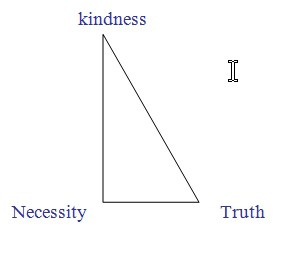Buddhas Creed states ‘It is necessary it is kind it is true.’ Why did Buddha emphasise these qualities. Show by way of examples how these inter relate and what happens when one of these is lacking ?
These three qualities which form Buddhas Creed can form the foundation of a spiritual path and would serve as a code of conduct in life, indeed is there any separation between the two ?
Below we will demonstate three scenarios showing a different balance between these three qualities and the implications for teaching and learning on the spiritual path.
(i) Kindness, Necessity & Truth in Balance
Ideally these three could be demonstrated in our actions at once. In balance these may be represented by an equilateral triangle.
Truth = A meditator who may need to increase the amount of meditation they need to do to reach their set goal as their current effort is not enough
Necessity or Honesty = teacher informs student that more effort is required.
Kindness = This is explained by the teacher in a constructive way giving encouragement and practical advice to overcome any fears or difficulties the student may have. This may simply involve looking at the meditators personal timetablefor the week and making something more condusive and organised around meditation
(ii) Truth and Necessity Present but Kindness Lacking.
This triangle demonstrates someone acting with Truth and Honesty but lacking in kindness hence the triangle is flatter as kindness is in short supply.
Truth = The aspirant needs to meditate more hours to achieve the progress he so desires and this is conveyed to them by their teacher.
Necessity = the teacher seeing the student struggle feels it is necessary to point out that the aspirant needs to put more effort into their meditation and is honest with them
Kindness (lacking) = when kindness is lacking it may well do more harm than good for the student. It does not encourage the student to feel safe in their environment with the meditation teacher and may encourage dishonesty in replies due to fear so truth and necessity without kindness is somewhat imbalanced.
(iii) Kindness and Necessity Present but Truth Lacking
In this example, if truth and kindness were swapped around, with truth in short supply then a possible example would be if someone were in much distress say through the loss of a parent. In this circumstance the teacher may feel the need to be kind through necessity but the information given by the teacher may be untrue in parts but is said to make some comfort to the aspirant e.g. you will see your lost parent again upon death.
(iv) Kindness and Truth present but Honesty or Necessity Lacking
 Truth = a meditation student who wants to improve the quality of their meditation is praised that they teach and meditate alot and this helps to reinforce what they are doing is right to reach thier spiritual goals.
Truth = a meditation student who wants to improve the quality of their meditation is praised that they teach and meditate alot and this helps to reinforce what they are doing is right to reach thier spiritual goals.
Kindness = the teacher is reviewing positive aspects of the students spiritual undertaking
Necessity or Honesty (lacking) = the student has a diet of meat and occasional alcohol. The teacher neglects to mention these things for fear of alienating the student which if stopped MAY improve the students meditation. So the student gets positive reinforcement but without the real issue being addressed.
In conclusion the examples above a relatively simple but they illustrate the point that truth, necessity & kindness need to be in balance for an effective teacher – student relationship.



